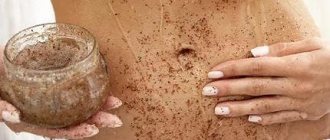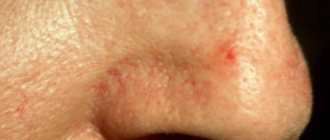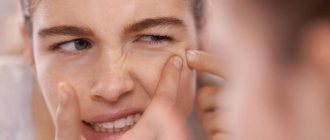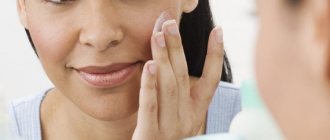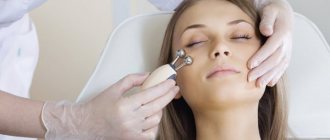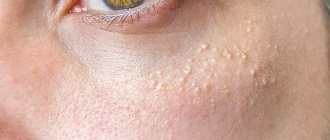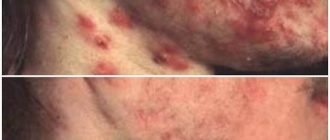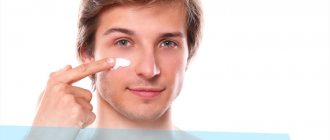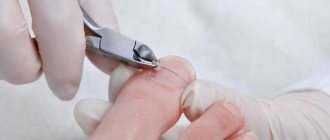Reasons for appearance
There are not so few of them.
And it’s not always a matter of oily skin, when when the ducts of the sebaceous glands are clogged, sebum accumulates and remains under the skin in the form of a white mass, which appears as a dark dot on the surface of the skin. Acne (comedones) can also occur in girls with dry skin when dirt and dust accumulate on it. If a person develops acne around the nose, this condition can be caused by the following factors:
- Restructuring of hormonal levels. Mostly pimples under the nose appear during puberty. A surge in hormonal levels is the main reason for the increase in the production of subcutaneous sebum, which is often the reason for its excessive accumulation in the pores. If teenagers do not eat or take care of their skin properly at this point, multiple rashes around the nose often occur.
- Unhealthy eating. Excessive consumption of alcohol, sweets and spicy foods increases the load on the liver. The deterioration of the filtration organ affects the condition of the facial skin.
- Constant stress. A disturbance in the psycho-emotional state causes an increase in the secretion of sebaceous secretions, which is why a pimple appears near the nose.
- Allergic rhinitis and colds. In these conditions, snot is constantly released from the nose, which is why the person rubs the nasolabial area. This leads to inflammation of the canals.
- Ignoring hygiene rules. Various pathogenic microorganisms, dust, dead skin, and cosmetic residues clog the canals and cause a rash.
Blackheads due to acne
Acne begins with the appearance of open and closed comedones, which can be considered “pre-pimples.” Factors have been identified that contribute to the formation of inflammatory red acne from comedones (papules and pustules, sometimes nodules and cysts). This:
- hereditary predisposition to oily seborrhea due to increased sensitivity of pilosebaceous complexes to androgens;
- endocrine disorders with an increase in testosterone levels in the body (for example, polycystic ovary syndrome);
- use of comedogenic cosmetics;
- constant contact of the skin with harmful substances (oils, fuel oil, tar, chlorine);
- taking anabolic steroids, antidepressants, oral contraceptives;
- self-medication.
In people with the problems described above, the bacterium Propionibacterium acnes (P. acnes) also settles in the pilosebaceous complexes, which, with the usual amount of sebum, does not cause harm, but in clogged pores it multiplies intensively and processes its excess into substances that irritate the skin.
It is precisely because of red pimples with white, festering heads that people usually turn to a cosmetologist. Although those who have a lot of comedones, including closed ones, should also be actively treated, since this is a comedonal form of acne, and not just clogged pores.
This is why self-medication, which usually consists of endless cleaning of black pores (often with dirty hands) and treating the skin with aggressive products, does not have an effect. And in many people, due to constant trauma to the pilosebaceous complexes, the disease develops into papulopustular and cystic nodular forms.
Structure of the upper respiratory tract
The clinical anatomy of the nose and paranasal sinuses has a very complex structure. The nose itself serves as the beginning of the human respiratory system and continues with a cavity connecting the upper respiratory tract with the paranasal sinuses.
At the base of the external nose is a skeleton of osteochondral tissue covered with skin. All elements of the organ consist of cartilage and bones and skin. In turn, the base and dorsum of the nose are composed of 3 types of bone elements, arranged in pairs. The cartilage system is also represented by three types, arranged in pairs.
The space called the nasal cavity is located behind the oral cavity and is divided into 2 halves by a cartilaginous septum. It has 2 pairs of holes: front and rear. The anterior ones are called nostrils, and the posterior ones are called choanae, descending into the nasopharynx.
The nasal cavity is surrounded by the so-called paranasal sinuses. In medicine, they are divided into 4 pairs and can be: frontal, sphenoid, maxillary and ethmoid sinuses.
In addition, these cavities are located in the near and far parts of the skull. The course of pathologies in them differs somewhat. This is explained by the fact that the anterior sinuses are connected to the nasal cavity by the middle, and the posterior sinuses by the upper nasal passage. At the same time, the incidence rate of the posterior sinuses is much lower than those located in front.
A detailed diagram allows you to see in which area of the skull the paranasal sinuses are located.
Removal tool
Professional cosmetologists use special tools for mechanical skin cleansing.
These include:
- Uno spoon;
- Vidal loop;
- Vidal needle;
- strainer.
These tools are available in specialized stores and are suitable for independent use at home. They allow you to conveniently and effectively remove each blackhead individually. Using tools, you can clean pores in hard-to-reach places, while doing it efficiently and atraumatically.
Getting rid of blackheads on the nose at home
- The principle of action of the mask against blackheads is simple: it lays a strong film on the prepared skin, and when you remove it, it “pulls out” the contents from the pores. It is not necessary to buy such a product at the pharmacy, because it can be easily prepared using simple ingredients. For example, from egg white: beat it well and coat problem areas, apply paper napkins on top and another layer of egg white directly on them. Try to keep the layers as thick as possible. Give the mask time to dry (20-30 minutes) and with a sharp movement, tear the napkins away from your face. The faster you tear off the napkins, the better the effect will be.
- We also recommend a homemade mask made from juice or milk (100 ml is enough) and a couple of tablespoons of gelatin. After heating the milk, add gelatin to it. After half an hour, place in a water bath (in a saucepan with water) and stir until the gelatin is completely dissolved. After giving the mixture time to cool, prepare your skin, remove makeup, and wash your face. Apply the mask in thick layers to areas with blackheads using a cotton pad. Half an hour after application, it’s time to remove the thick mask, starting from its edge near the chin. After removal, wash and apply moisturizer.
- One of the most effective remedies for spots is considered to be white clay (kaolin), which can be found in powder form in any pharmacy. Mix the powder with water to form a fairly thick mass and apply to problem areas, avoiding the area around the eyes and lips. After 15 minutes, you can wash off the mask.
- Another simple way is to apply kefir to the skin for 20 minutes. Thanks to the special acids in its composition, it is able to dissolve sebum, eliminating black nodules. This mask is especially effective if you have oily or combination skin.
- From what you always have on hand, you will also need regular baking soda. Pour baking soda into warm water and apply the resulting paste to your face for 40 minutes. It is recommended to make this mask twice a week for a month. As they say, cheap and cheerful!
- You can also prepare a mask to remove blackheads on the nose at home using oatmeal, salicylic acid, and lemon juice.
Most often, they resort to this method without understanding the problem and wanting to remove these hated defects from the face as quickly as possible - they simply squeeze it out. If you also decide to get rid of comedones, then follow simple rules: wash your hands thoroughly and treat them with alcohol or salicylic acid. Before the procedure, it is better to take a bath so that the pores are open and steamed.
Better make a homemade scrub. Rinse 2-3 tablespoons of rice and pour boiling water over it, leaving it in a saucepan overnight. In the morning, strain the rice and mash until it turns into a paste. The scrub is ready! You can make it from sugar, salt, crushed (in a coffee grinder) apricot kernels with the addition of honey, olive oil. This composition will not only remove blackheads on the nose, but also improve blood supply to the skin, making the face radiant and smooth.
We hope you find your own way to remove blackheads on your nose, but think about the root of the problem. Perhaps you indulge too much in sweets, fatty foods or are addicted to alcohol? It is these products that do not have the best effect on the condition of your skin and add to your problems. Try to arrange fasting days and pay attention to how your skin reacts to it. And eat more fruits, protein foods and foods rich in vitamins A and E - known helpers of your beauty.
This is my theme! I want to receive beauty life hacks and care tips.
We have sent a confirmation email to your email.
Prevention of comedones
The simplest thing you can do is not to be lazy every day, cleanse your skin. It is recommended to carry out these procedures several times a day. At least once a week you should pamper your face with a homemade caring mask, the composition of which can be chosen in any way, depending on the type of epidermis and problems.
How to get rid of blackheads at home on the nose with increased secretion of the glands? The answer is simple - find and neutralize the cause of its excessive presence. At the same time carrying out cosmetic procedures:
- For example, to prevent the occurrence of comedones, you can steam your face, rinsing it with cold water at the end of the procedure. As a result of constant care, the likelihood of the formation of cosmetic defects is reduced, since the pores are constantly cleaned.
- How to get rid of blackheads on the nose at home, in this case salt will come to the rescue. If there is increased sebum secretion, you can mix table salt with soap cream and apply it to your face, then rinse with water at room temperature after a few minutes. For dry facial skin, apply a rich cream, which is sprinkled with salt on top. The mixture is washed off after a minute with plain water. This natural ingredient can be mixed not only with cream, but also with cottage cheese, sour cream or oatmeal. To whiten your skin a little, you can add a little lemon juice.
How to get rid of blackheads on the nose at home using simple and proven folk methods?
The safest and easiest way to cleanse the epidermis is home remedies will help you with this. Natural cosmetics will thoroughly and carefully cleanse the epidermis, removing particles of old cells, bacteria, dirt, open pores, and restore the functioning of the sebaceous glands.
One of the simplest ways: lemon juice is the best way to cleanse the epidermis of all types of dirt and stains; it is a strong natural bleach:
- Apply lemon juice, previously well diluted with plain boiled water one to one, to problem areas and leave for 15 minutes, then rinse your face with cold water. For an additional and beneficial effect, mix natural lemon juice with fresh cucumber juice or honey. Cucumber promotes more intense skin whitening, and honey cleanses it well. Instead of juice, you can use apple cider vinegar.
You can come to the aid of your skin very quickly and on your own. How to get rid of blackheads on the nose at home? An anti-comedone mask will help you with this. There are many recipes for such an effective cosmetic product. Here are some of them:
- gelatin-based mask;
- chicken egg mask;
- yeast mixture;
- sugar-based massage mask;
- a mixture of soap and plain soda.
Most cosmetologists recommend using an inexpensive and accessible product that effectively cleanses pores of excess fat and dead epidermal cells.
To prepare the miraculous composition you will need the following ingredients:
- milk or juice – 100 ml;
- gelatin - a few tablespoons.
- bring the liquid to a boil and soak simple gelatin in it;
- after 20 minutes, place the container with the composition in a water bath, not forgetting to stir the gelatin until completely dissolved - the composition is ready;
- While the consistency cools to a pleasant temperature, thoroughly cleanse the skin of cosmetics and dust, wash with baby soap and pat dry with a paper napkin;
- cover your face with the resulting mixture;
- The gelatin mask must be dense, so after the first layer has dried, the next layer must be applied. Until the mask hardens, remain calm so as not to harm the structure of the mask. To do this, turn on some pleasant music and relax.
- After half an hour, when a smooth matte film forms on the face, the mask can be removed.
- Gently grab the edge of the film near your chin and pull it up.
If the composition was prepared and applied correctly, then on the inside of the mask you will see small tubercles - these are comedones. At the end of the procedure, wash your face with cold water and apply a layer of nourishing cream.
How to get rid of blackheads on the nose at home? The cheapest and most effective method is an egg composition, which perfectly cleanses the skin of comedones, gives smoothness, removes red spots and improves complexion.
Let's move on to creating a miracle remedy. For this you will need:
- egg;
- several small containers;
- napkins;
- scissors.
Separate the white from the yolk, then beat the white well and apply a thin layer to the surface of the face, covering with a napkin. Apply a second layer on top of the first layer.
After half an hour, with a sharp movement we open the resulting film from the skin. Be patient a little because there will be nasty blackheads left on the napkin. Wash your face thoroughly and apply beaten yolk.
After 10 minutes, remove it and you can admire your reflection in the mirror.
How to get rid of blackheads on the nose at home using 3% hydrogen peroxide and simple yeast?
Mix these two components thoroughly and apply the resulting mixture to the T-zone. After 15 minutes, wash your face well and wipe it with ice. Apply moisturizer to the code.
Hydrogen peroxide dries out inflammation, and yeast cleanses pores and improves complexion.
How to get rid of blackheads on the nose at home, an effective recipe - an equal ratio of baking soda and salt, mix well and apply to problem areas: nose, chin, forehead. Gently massage using patting movements and leave the mixture on for 10 minutes. Rinse off the mixture and enjoy beautiful and clean skin.
Soda perfectly whitens the skin, and soda dries out inflammation and eliminates comedones in the nose area.
It is important! This recipe can only be used if you have oily skin. Use no more than once a week!
How to get rid of blackheads on the nose at home? A massage mask will come to your aid. Stir the egg white and add a spoonful of sugar, making sure it dissolves well.
Cover your face with half the mixture and leave until completely dry. Apply the next layer and proceed to a light massage, gently patting the face. The viscous mass will draw out the dirt accumulated in the pores.
At the end of the procedure, apply moisturizer.
The result will satisfy you one hundred percent!
Comedones on the nose, which are visually black spots, appear in both male and female representatives. This is all due to the improper functioning of the sebaceous glands in the nose area. The black color of the spots occurs because the oil and skin cells that clog the pores come into contact with air. When reacting, the color of the dots becomes dark.
Causes
Open comedones appear near the nose and on the respiratory organ for the following reasons:
- changes in hormonal levels;
- the functioning of the gastrointestinal tract is disrupted;
- using cosmetics that clog pores every day without properly cleansing them;
- contaminated air;
- use of soap for washing, which dries the skin on the nose.
Treatment
There are various ways to get rid of pimples on the nose that look like blackheads. These include:
- daily cleansing of the skin using suitable care products;
- periodically visit a cosmetologist who performs professional facial cleansing;
- use various lotions, masks, tonics, foams, etc. at home;
- for more advanced cases, you can use pharmaceutical preparations based on zinc, salicylic acid, etc.
White pimples, also called closed comedones, appear as a rash. They are small white tubercles, dense, no more than 1-2 mm in diameter. In rare cases they can reach 5 mm.
Closed comedones are not painful. If you don’t comb them and don’t constantly touch them with your hands, then they don’t cause discomfort to a person. However, they create uneven skin and roughness on the nose.
Causes
They may appear for the following reasons:
- disturbances in the functioning of hormones in the body;
- poor skin care;
- various nervous shocks, stress, breakdowns;
- poor nutrition due to large amounts of sweet, starchy, spicy foods;
- drinking alcohol and smoking;
- disturbances in the gastrointestinal tract;
- hereditary predisposition
- genetic predisposition, heredity.
Symptoms
Closed comedones appear in groups and are painless unless you squeeze them out yourself. This can provoke inflammation at the site of mechanical impact.
Treatment
A type of acne in the form of white, dense small rashes can and should be treated. The following methods are used:
- treatment with drugs from the pharmacy, for example, Zenerit, Skinoren, ichthyol ointment, salicylic acid;
- going to a cosmetologist for professional facial cleansing;
- steaming at home;
- facial peeling in the nose area.
Folk remedies
Folk recipes are based on the use of herbs and products for cosmetic purposes. They are used to make homemade masks and lotions against sebaceous plugs. Their main advantage: naturalness.
- Protein mask. One protein is mixed with one tablespoon of sugar. Apply to face and leave until dry. Then apply a second layer using patting movements, creating a stretching adhesive mask. Continue manipulation until the substance stops sticking to your fingers. Wash off the mask and then moisturize the skin with cream. Repeat 3-4 times a week.
- A product based on salt and soda. The substances are mixed 1:1. Moisten a cotton swab and dip into the mixture. Treat comedones with it, lightly wiping the skin. Repeat once a week.
- Kefir mask (for those with oily and combination skin). Apply kefir to your face and leave for up to 20 minutes. Then wash it off.
- A gentle product for sensitive skin. Add a few drops of lemon juice to honey, apply to areas of the face where there are blockages, leave for 10 minutes, and wash off.
Blackheads on the nose: remove with masks
Cosmetic defects on the skin are always depressing. A common problem that significantly spoils the appearance is blackheads occupying the face. They are called open comedones.
This problem occurs due to clogged pores with fatty secretions that mix with skin particles, dust and cosmetic residues.
You can defeat them in different ways, but you need to learn how to get rid of blackheads on your nose before using radical methods. If you act incorrectly, you can achieve the opposite result.
Reasons for appearance
The sebaceous glands have a noble mission. Ideally, they are designed to moisturize and serve as protection for the skin from the influence of the external environment. But it is simply necessary to understand why such points appear when they should not exist. If you do not know the mechanism of their occurrence, a person will be powerless. Comedones on the nose and other parts of the body are formed due to the following factors:
- Temporary changes in hormonal levels. Most often, adolescents discover spots at the beginning of puberty. A similar nuisance happens to women during pregnancy or menopause.
- Irregular cleansing of the skin or, conversely, excessive care with inappropriate products that dry it out.
- Inherited tendency towards enlarged pores.
- Distortion in nutrition. The abundance of flour, sweets, the absence or a meager amount of necessary fiber provokes problems in the gastrointestinal tract, and the result is problematic skin.
When thinking about how to deal with blackheads on the nose, one cannot help but take into account possible skin trauma. Therefore, all procedures must be carried out strictly according to the rules.
This option for getting rid of dots has a right to exist, since comedones on the nose can be removed using this method in the shortest possible time.
One-time visits to a cosmetologist or occasional cleansing and masks against blackheads will not help. You should take care of your face daily, using an integrated approach, combining salon treatments and home facial skin care methods.
You need to act slowly and carefully:
- refusal to steam the skin leads to a decrease in the effectiveness of the procedure, because it will not be possible to clean the pores efficiently;
- be sure to take steam baths with those additives that are ideal for your skin type;
- manipulation with dirty fingers is prohibited, so treatment with bactericidal agents is necessary.
The result of cleaning the skin on the nose will be desirable if you take into account several nuances:
- To prepare a bath, you can use boiling water, but decoctions or infusions of herbs (calendula, linden, chamomile, horsetail) are more effective. It is recommended to add 1-2 drops of clove, bergamot or tea tree essential oil.
- The face is cleansed before the procedure. The tip of the nose should be at least 25 cm from the surface of the water. To prevent steam from escaping, cover the head with a terry towel. The duration of the bath is 10-15 minutes. But you need to take into account your skin type, since rapid and intense sweat will lead to dryness of normal or dry skin.
- After steaming, excess moisture is removed from the face with a paper napkin, hands are washed thoroughly, treated with alcohol or hydrogen peroxide. Wrap your fingertips in a paper towel, then carefully squeeze out the blackheads.
- After removing comedones, wipe the nose and entire face with lotion or peroxide.
Next steps may vary. If the skin is prone to intense sebum secretion, sometimes after disinfection a mask is applied to the face to tighten the pores (egg white or clay). To complete the facial treatment, apply a cream with a light texture to the skin. This procedure is done only once a week.
Cleansing masks
Those with spots on the nose are interested not only in the question of how to cleanse their skin of comedones. I would like to know what can be done to maintain its optimal condition between cleanings. Masks are very helpful with this, acting carefully but effectively.
This combination draws out the contents of the pores, rids the surface of the skin of dirt and dead particles. The face is cleansed and steamed. Mix cosmetic clay (1 tbsp) with powder from two charcoal tablets, add a little cool water. Bring the mixture to the consistency of sour cream. Apply it with a cotton pad and leave for 20 minutes. Wash off the mask with cool water.
Soda and salt
This mask not only gets rid of oily shine, but also relieves inflammation and successfully helps clear pores of secretions. The procedure begins with cleaning and a steam bath. Mix salt and soda (1:1) well, dip a damp cotton pad, and massage the nose with gentle circular movements. The composition is washed off immediately, after which a suitable cream is applied.
Aloe, lemon and protein
Lemon juice, egg white and aloe juice (approximately equal parts) are whisked in a blender. Apply the first layer to the skin, wait until it dries completely, and add a second one. Leave for 10 minutes, then wash off.
Don't forget about normalizing your lifestyle. This means breaking bad habits, eating more vitamins and exercising. The skin is a reflection of the work of the entire body, so it’s worth starting with healing yourself from the inside.
Such masks do not cause severe irritation, so you can use them even twice a week.
Scrubs and peelings
A cleansing scrub is an effective remedy for blackheads on the nose. It gets rid of comedones, various impurities, and dead epidermal cells. Ground coffee, sugar, soda, salt, and zest are often used for exfoliation.
Coffee beans will help clear your nose of spots; it is better to use freshly ground ones. In 1 tbsp. l. powder is added in the same amount of crushed rolled oats and sour cream. Only those places where the points are located are treated with a scrub.
To obtain a scrub, mix 5 g of salt with 30 ml of sour cream. Apply the composition exclusively to those areas of the nose where the points are localized. Before removing the mixture, massage the area thoroughly and leave for 5 minutes.
Honey and semolina
Take 1 tbsp. l. liquid honey, add a little semolina to it, mix. Apply the composition to the nose and other problem areas. After 2-3 minutes of active massage, the mixture is washed off.
After such procedures, wipe the face with a mixture of protein and lemon juice (1 tablespoon) or ice cubes. Then moisturizer is rubbed into the skin.
Other means
In addition to the usual folk remedies, there are pharmaceutical preparations that allow you to quickly get rid of unsightly spots. These primarily include ointments.
- Differin. The active substance is an analogue of retinoic acid, a derivative of vitamin A. The drug reduces the production of fat, removes the contents of comedones, draws out toxins, simultaneously removing dirt. The ointment is applied once a day only to the problem T-zone - nose, forehead, cheeks, chin. Differin is not suitable for normal to dry skin.
- Zinc ointment. An inexpensive remedy that successfully combats many similar diseases is also suitable for removing blackheads. It has no contraindications; the ointment is prescribed even for children. Being an antiseptic, it prevents the spread of bacteria, softens comedones, narrowing pores.
- Ichthyol ointment. An inexpensive drug that relieves various inflammations, has a healing effect on the condition of the epidermis, and improves blood circulation in it. To free the nose from spots, the ointment is used in a mixture with glycerin (1:4), applied at night. The composition is able to remove comedones in several procedures.
- Cleansing patch. Instead of mechanical cleaning, you can use strips with an adhesive substance that will do all the work. The nose is moistened with water, a patch is glued, and after 10 or 15 minutes it is abruptly torn off. There are no painful sensations, as well as points that move away along with it. These strips are recommended to be used 2-3 times a week.
The simplest and most effective way (but, unfortunately, does not solve the problem forever) is to use a patch (plaster), which is also called “beauty stickers.” It is created on a fabric basis and has a special shape so that it is easy to stick to the area of the wings of the nose. The patch should be used when the skin is steamed and the pores are open.
For a long-term solution to the problem, you should choose a cream or gel against blackheads. It is applied in a thin layer after cleansing the skin. The cream should contain salicylic acid, which helps the natural death of particles and renews the skin by neutralizing bacteria. Another component of such creams is benzoyl peroxide.
Such products not only help get rid of blackheads, but also improve their complexion; some even stop using foundation. But this method also has a downside: creams with alcohol components dry out the skin, and the sebaceous glands begin to replenish moisture loss and produce even more sebum, which means the appearance of comedones is provoked.
- Keep your eyes peeled: everything you need to know about eye care products
In addition to pharmaceutical products, hardware facial cleansing procedures, which are done in beauty salons, can help. Moreover, now they can be carried out at home using devices with a rotating brush attachment. Thanks to the micro-oscillations of the brush, the skin is not damaged, the pores are cleaned, and after a couple of weeks, blackheads stop appearing.
Salon treatments
Using home remedies is a matter of trial and error. Without special education, it is difficult to choose the ideal care for yourself. That's why many girls turn to salons. In order to clean pores, specialists carry out the following procedures:
- Mechanical cleaning. The same extrusion, only professional.
- Ultrasonic. A painless procedure that stimulates regeneration processes.
- Vacuum. Cleans the deepest dirt using a tube that creates pressure. A life hack with an ampoule is a home analogue of this manipulation.
- Chemical peeling. Removing comedones with fruit acids that dissolve blockages.
- Vaporizer. Hardware steaming of facial skin.
Vacuum cleaning
It is carried out with a special tool that creates pressure. So, the sebaceous plugs are literally pulled out.
- Benefit: Effectively clears even the most serious blockages.
- Contraindications: dry, sensitive skin, inflammation, dermatological lesions.
- Process: before manipulation, the pores are opened with a vaporizer or the face is prepared with warming creams, then a vacuum tube is taken and passed over the entire surface. The procedure takes up to an hour, the cleaning itself takes 15-20 minutes. After the manipulation, a soothing mask is applied.
Mechanical cleaning
Although this type of cleansing can be done at home yourself, the effect of a professional procedure cannot be compared with it. Firstly, the masters use high-quality preparations to treat the skin, and secondly, they remove comedones carefully, using their fingers and special tools.
- Benefit: painstaking manual work guarantees the removal of all contaminants.
- Contraindications: dermatitis, menstruation (inflammation will appear), sensitive skin, vessels close to the upper layer of the dermis.
- Process: first, wash the face with an antibacterial solution, then apply soothing and steaming ointments or gels, or expand the pores with a bath, and then begin squeezing. The cleaning itself takes up to half an hour, the entire session – about 1.5-2. After squeezing, a mask is applied to tighten the pores and the Darsonval device is used to speed up skin healing.
Pathologies of the paranasal sinuses
In 90% of cases, pathological changes are associated with inflammatory processes. They can have varying degrees of severity and strength of impact on the body, so in 60% of people the changes occur in a mild form. In 70% of cases, inflammation begins to develop under the influence of bacterial microflora.
The paranasal sinuses suffer in most cases because a pre-existing ENT disease remained uncured or the therapy was chosen incorrectly.
The sinuses, whose structure is complex, react to changes in the body with the appearance of various forms of diseases.
| Disease | Affected sinus |
| Sinusitis | Maxillary |
| Frontit | Frontal sinuses (cavities) |
| Sphenoiditis | Wedge-shaped |
| Ethmoiditis | Sinuses of the ethmoid bone (located in tissues) |
Symptoms of pathologies manifest themselves in varying intensities. The forms of the problem can be acute or chronic.
General development parameters:
- high temperature - an average of 38.6 degrees;
- sense of smell is completely or partially absent;
- congestion is strongly expressed. In some cases, only mouth breathing remains available.
Characteristic symptoms indicating sinus problems:
- the eyeballs are compressed;
- Strong headache;
- a feeling of stuffiness in the ear (on the side where inflammation is present, clicking);
- darkening of the eyes (in difficult cases – fainting);
- toothache (if the maxillary sinuses are affected).
A special symptom is the appearance of swelling on the face. It indicates from which side the inflammatory symptom arose and is developing. In 20% of cases, tumors (benign or malignant) appear during the development of sinusitis. Benign are divided into congenital and acquired.
Types of pimples
Pimples under the nose vary depending on the factor that provoked them, as well as the individual characteristics of the patient’s body. There are 3 types of acne in the nasolabial area:
- Comedones. They come in both black and white. They occur due to keratinized skin, dirt or subcutaneous sebum that has accumulated in the pores. If the top of this rash comes into contact with air, it turns black over time. White formation is observed when the pore is closed.
- Purulent. When an infection gets into the sebaceous ducts, an inflammatory process occurs, as a result of which acne forms. If appropriate therapy is not carried out, infection can also affect adjacent tissues.
- Subcutaneous. They mainly develop due to exposure to pathogenic microorganisms or hypothermia. Often the internal pimple has a red tint and is quite painful.
Disorders of the autonomic nervous system
The autonomic nervous system is divided into two sections: sympathetic (responsible for excitation processes) and parasympathetic (responsible for inhibition processes). Normally, the predominance of one department over the other occurs as follows: the parasympathetic system works at night, and the sympathetic system during the day.
However, sometimes this balance is upset: when stressful situations arise, increased physical activity, during the recovery period after illness, lack of sleep and many other reasons. And, as a rule, the sympathetic nervous system begins to predominate. In this case, the production of sebum by the sebaceous glands increases.
Physiotherapy
The technique is a complex of several procedures:
- electrophoresis;
- magnetic therapy;
- laser therapy;
- pulsed current;
- UHF;
- ultrasound;
- Ural Federal District.
Procedures:
- are carried out completely without pain;
- help relieve inflammation;
- reduce the severity of edema;
- pain inside the nasal cavity and in the area of the damaged sinus subsides, then completely disappears;
- there is an activation of the body’s natural forces (the immune system awakens and strengthens), the impact of the infection is reduced;
- blood flow and circulatory processes return to normal levels.
After 1-2 procedures, inflammation decreases, it is noted that the blood contains fewer components coming from the source of inflammation (toxins). A one-time procedure reduces the severity of symptoms and improves well-being. Repeated procedure reduces the risk of complications.
Important for recovery! The paranasal sinuses are complex and closely connected with other systems and organs, so the inflammatory process is a dangerous source of bacterial infection that can affect the sinuses. Physiotherapy treatment for rhinitis should be started immediately.
Red pimples on nose
Causes
They can arise for certain reasons. Diagnosis of acne of this kind is very important, since the correct treatment of red rashes on the nose depends on it. Reasons include:
- hormonal imbalances in the human body (adolescence, approaching menstruation, taking specific medications);
- bad habits, for example, smoking, drinking alcohol;
- the presence in the diet of a large amount of spicy, fatty, smoked, sweet foods;
- improper facial skin care;
- stress and other manifestations of emotional and nervous disorders.
Symptoms
In enlarged pores, blockages begin to appear due to excess sebum secretion. This is a favorable environment for the growth of bacteria, which causes inflammation and redness of the skin on the nose.
Treatment
Red pimples on the nose in men and women should be treated. The methods are:
- periodic visits to a cosmetologist for facial cleansing and other caring procedures;
- the use of ointments and gels with a drying effect, for example, which contain salicylic acid, zinc;
- It helps well at home: masks made of clay, but only natural (white, green, black);
- among folk remedies, infusions and lotions from calendula, lotions with soda, rubbing potato juice into pimples, applying aloe to the inflammation help.
If these methods do not completely get rid of red pimples, you should consult a doctor.
The appearance of a large pimple on the nose is an unpleasant occurrence. They not only spoil the appearance, but also cause discomfort and self-doubt.
Causes
- the skin on the nose and entire face is too dry;
- hormonal imbalances;
- This is how allergies manifest themselves;
- pimple, as a result of strong compression of the skin, since blood flows poorly to the location of the future formation;
- hypothermia;
- clogging of pores with sebum
Symptoms
Large pimples on the nose are painful. Most often these are subcutaneous neoplasms. They very rarely appear in large numbers. They usually come out one at a time. At first, a slight redness appears on the skin. In 2-5 days, inflammation is completely formed and the pimple becomes noticeable on the skin (a tubercle appears).
Treatment
How to cure a pimple of this type - first, you should contact a specialist who will identify the true cause of its appearance and prescribe an effective treatment. It happens that you cannot do without taking antibiotics. Additionally, vitamins may be prescribed.
It is not recommended to use medications on your own, much less squeeze them out. You can only aggravate the negative consequences.
And being in the fresh air and proper external skin care on the nose and face will be appropriate.
